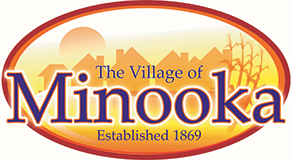In 1888 the Elgin, Joliet & Eastern Railroad built a branch line, which ran from Gardner to Plainfield, where it joined the EJ & E. This railroad was used to carry coal and freight from the coal mines south of the Illinois River to the Steel mills in the Joliet and Chicago area. This station stood just north of Minooka on Wabena, just past I-80. These are the tracks that run alongside of the schools.
Our History
Compiled by Michele Houchens
Until 1852, the site of the village of Minooka was a grass covered prairie hill overlooking the Illinois River valley. It was supposedly a favorite hunting area for the Pottowatomi tribes who lived in the area until the 1830’s. Early white settlers came to the area to stay in 1833. The Village of Dresden, located to the south of Minooka was begun by one of the first settlers, Salmon Rutherford, and thrived along the I & M Canal only to fail with the coming of the railroad to the north.
The Chicago, Rock Island and Pacific Railroad put down tracks from Chicago to Ottawa in 1852. Ransom Gardner, a surveyor for the railroad purchased 500 acres in the northeast corner of Grundy County and plotted the town. George Comerford, another early settler, was made the town’s first railroad agent.
Originally called Summit, because the town was the highest point on the Rock Island Line. In the late 1920’s the railroad cut a “pass” through the village in an attempt to level the grade that plagued engineers on the long freight and passenger trains. As a result, the tracks lie 13 to 15 feet below the level of Mondamin St. Until this point the tracks were level with the street with businesses on both sides of the street.
The Village was given its name by Dolly Smith who was the wife of Ransom Gardner’s agent in town, Leander Smith. She spoke the Pottawatomi language and called the town Minooka. It has been said that the meaning of the word is high point, place of contentment, good Earth or place of the maples. She also named many of the streets. Mondamin means corn in the Pottowatomi language. An old deed records the name as Anoka.
Minooka was granted its charter and incorporated in 1869. Leander Smith was named Village President. A. K. Knapp, William Jordan, Thomas Harris, and S. B. Alsdurf were elected trustees.
St. Mary’s Church was organized in 1862. There was a Catholic Church in the village of Dresden, St. Anthony’s, but members followed the businesses and public interests to Minooka. The current St. Mary’s Church was built in 1905 after a fire destroyed the church that once stood to the east of St. Mary’s Cemetery.
The Minooka Methodist Episcopal Church was organized in 1856. The original church building was destroyed by a tornado in 1917. The current building was built soon after and has undergone much renovation and growth over the years.
Minooka has contained two hotels, a horse racing track, a toboggan slide, a movie theater, many factories, businesses, social organizations and many, many wonderful citizens.
In 1909, the Chicago, Ottawa and Peoria Electric Line, commonly known as the Interurban, was begun between Joliet and Depue, IL. This was a quick and cheap means of transportation for people and for freight between the towns on this line. Trains ran daily, stopping in each town along the line, and sometimes in between towns of too if requested. Extra cars were put on the trains on Sundays, when crowds would come to Minooka to watch horse racing at the racetrack on the south edge of the village, where the high school is now located. In the photo, notice the three story building in the background, this was the Union or Hamilton House Hotel that stood at the corner of Wabena and Wapella from 1858 until the early 1960’s.
Looking west toward the corner of Mondamin and Wabena. The original water tower was installed in 1906 and was constructed of redwood. The grassy area where the photographer was standing is now Veteran’s Park.
Looking north from Wapella, c1910
There is no hill by the train tracks! Minooka was and still is the highest point in Illinois on the Rock Island Line. Early railroad workers called Minooka “Summit”. The tracks were lowered in the 1920’s so trains could make the grade into Minooka. Before the tracks were lowered, there were businesses on both sides of Mondamin. In the lower left-hand corner of the picture, a cow is grazing in the open lot.
In 1852 the first train entered Grundy County as what later became the Village of Minooka. The Chicago, Rock Island and Pacific Railroad, as it was known in its earlier days initiated Minooka’s founding and growth. This station stood by the tracks, after the tracks were lowered, the station was moved up to the area known as Veteran’s Park.
During the mid-1880’s A.K. Knapp built a toboggan slide for the people of Minooka and the surrounding area. Knapp was a prominent businessman in town, owning a bank, the grain company and the lumberyard. Each fall the slide was erected on Osceola St. beginning at the top of the hill towards the elementary school driveway and extending south along the street. The slide was taken down in the spring and stored. The condition of the slide deteriorated over the years and after Mr. Knapp’s death in 1904, it was not replaced.
Contact Us
121 E. McEvilly Road,
Minooka, IL 60447
